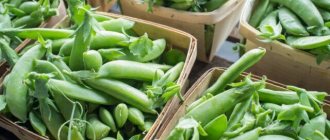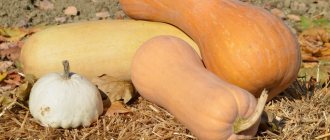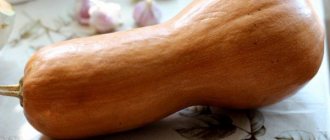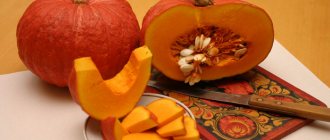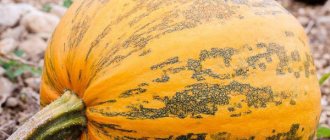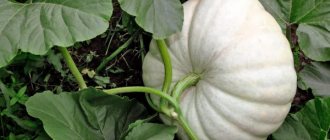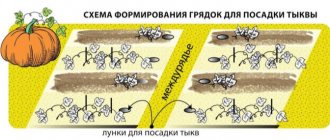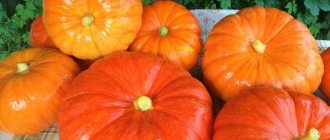It is believed that large-fruited pumpkin varieties originated from Central, South America and Asia, while small ones were found wild in North Africa.
In Russia, the plant has been cultivated since the 16th century, quickly took root, and first became popular among peasants - the fruits were used in the preparation of many national dishes and were used to feed livestock. Now the product has found application in official and folk medicine, cosmetology, and dietary nutrition. The best varieties of pumpkin are used to make gourmet dishes in expensive restaurants.
Pumpkin has a number of advantages: it is healthy, has a long shelf life, and is easy to grow. But not everyone likes to eat it. This is partly due to the limited number of recipes that housewives are accustomed to using, but sometimes they simply choose the wrong variety, and the food variety of pumpkin is served to the table.
Botanical description
Pumpkin (Cucurbita) is a genus of heat-loving herbaceous plants from the Cucurbitaceae family. There are about 20 species, some annual and perennial. When grown in Russia, the growing season is limited to one season.
According to the nature of the growth of the aboveground part of the pumpkin, they are divided into:
- Long-climbing, in which a thick, creeping, branched main shoot can reach 15 m. There are thinner lateral shoots of the first, second, etc. orders.
- Bush - with shortened vines from 50 cm to 2 m in length. Internodes are located close to each other, there are few or no side shoots.
The stem is covered with hard, moderately spiny hairs; depending on the species, it can be round in cross-section or faceted. The leaves are dense, often rough, of different shades of green, located on long petioles. Shape – round, heart-shaped, solid or with grooves of different depths, five-lobed.
After 6 or 7 leaves, branched strong tendrils appear on the pumpkin, with which it clings to neighboring plants. This increases the plant's resistance to wind.
The root system is powerful. The main root is a taproot and goes to a depth of 2-3 m. Lower-order shoots spread wider in the arable layer, covering an area with a diameter of up to 4-5 m.
Pumpkin is a monoecious plant; the flowers are divided into male and female. They are short-lived, bell-shaped, large, five-petaled, yellow or orange, less often white. Placed on the main shoot and side branches. Pollinated by insects.
The fruit from a botanical point of view is a false berry (pumpkin). Comprises:
- shell, which becomes very hard after ripening;
- pulp;
- hollow inner chamber with numerous seeds.
The shape and size depend on the type and variety of pumpkin. Some are small, the size of a fist, others are gigantic. They can be round, flat-round, elongated, pear-shaped, thin and long. Decorative pumpkins amaze with their whimsical outlines. The outer color is varied, the flesh is usually yellow or orange, but can be white, cream, or greenish.
Store pumpkins under normal room conditions. Most varieties last until Christmas, but there are some that even in hot climates do not spoil for 2-3 years.
The main thing about planting and care
A record harvest begins with the right choice of site. When deciding where it is best to plant a pumpkin, you should remember several of its main requirements: light, warmth, nutrition.
A compost heap is not suitable, although this option seems very tempting: pumpkin has a tap root that reaches a length of 2 m, and this is a very “voracious” plant that will pull most of the nutrients from the heap in just one season.
What kind of soil does pumpkin like? Loose, air- and water-permeable, without stagnation of water. Very nutritious, with an abundance of organic matter and added minerals. Dense and acidic soil, on which a soil crust easily forms, is strictly contraindicated.
The pumpkin planting pattern depends on the variety. The distance between plants of long-climbing varieties with large leaves is from 1 m, if possible up to 2 m.
Bush or short-climbing varieties are planted more densely, with a distance between holes of 0.7-1 m, in a square-cluster method. It is convenient to grow pumpkin as a compactor for other vegetable crops, without dedicating separate beds for it.
Caring for pumpkin plants after planting involves watering them in a timely manner - be careful, not with cold water! - and weeding. In the spring, you need to be able to protect seedlings or planted plants from frost at any time, for which you should always have dry hay or grass, plastic film, non-woven covering material, and wooden containers in stock.
One of the important rules for planting and caring for pumpkins is one that gardeners usually forget about or simply do not attach importance to: pumpkin vines cannot be moved or turned over, tearing them off at the rooting sites! Therefore, when the vines become long enough, they stop weeding out the weeds around them, especially those to which the pumpkin clings with its tendrils.
Pumpkin varieties: classification by ripening time
Pumpkin fruits ripen at different times depending on the type, variety and region of cultivation. With biological ripeness, the peel becomes hard and acquires a characteristic color.
There are different types of pumpkins:
- early, 90-113 days pass from germination to harvest, sugar content – 5-9%;
- medium ones ripen in 135-140 days, carbohydrates - 7-13%;
- the later ones are the most delicious, but already in the middle zone they must be grown through seedlings, until maturity - 140-160 days, sugar content - at least 11%.
Pumpkins are not tasty immediately after picking. They are left to ripen for at least a month.
How to distinguish a feed pumpkin from a table pumpkin
Fodder pumpkin is more productive, but not as tasty as table pumpkin. It can be eaten not only by animals, but also by people, the main differences are:
- very large fruits;
- rarely gets sick;
- high productivity;
- a lot of seeds;
- contains few carbohydrates;
- the internal cavity is of large volume.
Table pumpkin varieties have a small empty hole. The bulk of the fruit is pulp. Any type of cultivated pumpkin can be used as fodder, but most often cattle are given Large-fruited or Hard-barked ones.
TOP pumpkins by sugar content
Gourmets often argue about which type of pumpkin is the sweetest, since everyone's tastes are different. An objective criterion is the percentage of natural sugars in pumpkin pulp.
- Truly sweet varieties accumulate them in the range of 6–11% (for others this figure does not exceed 3–5%).
- “Champions” contain 8 – 13%.
So, the sweetest varieties of pumpkin:
Winter dining room A 5
This is a climbing Krasnodar variety, bred back in the 40s of the twentieth century. Used in further selection. Sugar content 9–13%. Ripening time is medium (in the North Caucasus) or medium-late (in temperate climates, through seedlings).
Pumpkins are flattened, weighing up to 7 kg, gray on the outside. When cut, there is dense orange pulp. The keeping quality is excellent.
Winter sweet
Sweet Winter pumpkin is a popular modern variety that is not prone to nitrate accumulation. Depending on the region and weather, mid-season or mid-late. Resistant to anthracnose disease. The stems are quite long.
Fruit weight 4 – 7 kg (sometimes twice as much); The outer color is spotted gray, the inner color is orange-yellow. The consistency is not loose. The taste fully justifies the name (about 8% sugar). Long-term storage.
Winter sweet Dining room winter A 5
Chit
It ripens 4 months after germination, filling up to 2 – 3 kg. Easy to grow, not affected by anthracnose. Pumpkins are soft gray on the outside and deep orange on the inside. The seed chamber is small.
The pulp is not watery, slightly crunchy; sugar content over 9%, even in temperate climates.
Michurinskaya
A modern early ripening variety that ripens in 3 months. Produces fruits measuring 4–7 kg. Tolerant to drought and cold snaps (withstands even frosts down to -0.5 degrees). The stems are long. Pumpkins are segmented, spherical-flattened. The skin is gray and thin.
The pulp is thick, bright orange, fiberless; accumulation of sugars – up to 10%. Storage is long, and the sweetness increases 1 – 2 months after harvesting.
Marble
Mid-late, climbing pumpkin. It got its name Marble because of the contrasting spotted pattern on the skin. There are no cracks or white rot on the fruits; they are stored excellently. Weight 4 kg; the shape is spherical-flattened, with small ribs.
The average sugar content is 9%, the maximum is 12%. The pulp is not mealy, juicy and tender.
Orange honey F1
Climbing hybrid of medium ripening period, weighing 1.8 – 3.7 kg. Pumpkins are flattened and striped. From the inside they are very bright - red-orange.
The consistency is balanced in juiciness and density, the taste is excellent. Shelf life - about 5 months.
Orange honey F1
Marble
New
The stems are long and need pinching after the ovaries form. This mid-season (120 days) butternut squash produces club-shaped fruits. Can be stored for 8 months. When fully ripe, the skin is pinkish-orange.
The pulp is very juicy, orange in color; sugar content - 10%.
Large pumpkin
The Latin name of the species is Cucurbita maxima, its homeland is South America. The fruits of the Large-fruited or Giant pumpkin are the largest of the cultivated plants. A record weight of 1190 kg was recorded in 2016 in Belgium.
An annual herbaceous plant. It usually forms powerful shoots with cylindrical, thick, pubescent shoots up to 10 m long, but there are also compact bushy varieties. The leaves are soft, kidney-shaped, often with shallow notches, and green.
The flowers are yellow, bright, large, with bent petals. The calyx is bell-shaped, with thin sepals. The seeds are quite large, white to coffee-colored.
Pumpkins are round or oval, usually very large, in some varieties or varieties they can reach tens or even hundreds of kilograms. The cover color is orange, white, gray, green, pinkish. The surface is ribbed or smooth. A distinctive feature is a short, soft, cylindrical stalk.
Large-fruited pumpkins have three large subspecies and many small forms and varieties of pumpkins. It is difficult for a simple gardener or cook to figure out which of them belongs to the well-known or not so well-known varieties in Russia.
South American subspecies
Features: powerful, rigidly pubescent, long lashes. Ripens late. Lower taxa:
- Chilean - with round light gray pumpkins and thick orange flesh;
- The turban-shaped one differs from the previous one by the presence of a turban-like protrusion on the fruit;
- The top-shaped one is similar to an asymmetrical spinning top (top), the cover color is greenish-gray, after ripening it can turn red, the flesh is sweet and dense, the surface is uneven (varieties - American Gobbard series);
- Bush - the name refers to the shape of the plant, the fruits are small, up to 0.5 kg, flattened, contain a lot of carotene, with a hard peel;
- Bolivian - with small or medium pumpkins, brown seeds, woody bark;
- Peruvian is distinguished by large fruits with soft skin and oval shape, brown-red seeds.
West Asian subspecies
Forms plants with vines of medium thickness and length, softer pubescence than the South American subspecies. Most varieties manage to ripen in the open ground of the European part of Russia.
Junior taxa:
- Gray round - with spherical or slightly flattened fruits at the poles, the peel is gray-green, after full ripening it usually acquires a pinkish tint, the flesh is loose or of medium density (Volzhskaya gray, Dunganskaya varieties);
- Winter - the pulp is usually sweeter, gray pumpkin, long-lasting (varieties - Spanish, Stolovaya Zimnyaya, Cherkesskaya);
- White - differs from the previous ones in the cover color (varieties - Bezenchukskaya white, Honey white);
- Whale - the fruits are large, elongated, in cultivation represented by the only variety Kit;
- Mammoth - large-fruited, looks like smooth or flattened balls, the peel turns pink early (varieties - Shestipudovaya, Mamontovaya, Etampskaya, Ispolinskaya);
- Oval-fruited - what a pumpkin looks like is clear from the name of the variety; varieties, for example, Alashehir, come from Asia Minor and are grown mainly there;
- Banana - pumpkins up to 0.5 m long, 12-20 cm thick;
- Small-fruited - with a diameter of no more than 25 cm, varieties are selected in Japan (Bouquet).
Chinese subspecies
The plants are weak, tender, with flattened small and medium-sized fruits, obligatory turban-shaped formation at the top. The bark is thin and woody. It is eaten at a young age and is often used as a decorative item.
Distributed in the Far East and Western China. Varieties – Episcopal, Small Chinese.
Pumpkin for records
Some people prefer to grow portioned pumpkins that are easy to transport and quickly eat, while others prefer huge pumpkins of record size and weight.
You can’t move these without special equipment, and to eat them you need to call a lot of helpers. But such fruits and their owners end up on the pages of newspapers, on TV, and become Internet stars. Champion pumpkin seeds are quite expensive, and growing a giant fruit is not easy (and, alas, also expensive).
If you want to try your luck in this unique sport - growing a heavyweight pumpkin, you will have to forget about the whole world variety of pumpkin varieties, because only one single variety, the Atlantic Giant, is used for the record. Since 1979, no other pumpkin variety has been a world champion.
The best varieties of large-fruited pumpkins
From the point of view of consumer value, many varieties of large-fruited pumpkin are fodder. But among them there are some really tasty eateries.
Volzhskaya gray 92
Agriculturally registered in the State Register since 1940. Gray pumpkin of the Volzhskaya variety is extremely popular in Russia. Despite the large fruits, it is recommended for consumption.
The plant is powerful, with vines up to 8 m long, large leaves, petioles 25 cm or more. Pumpkins are mid-ripening, slightly or medium flattened, light gray, without a pattern. Weight – 6-9 kg, leathery bark.
The pulp is yellow or cream, up to 4.5 cm thick, medium density and sweetness, the seed chamber is large. The fruits have a long shelf life and are easily transported.
Gribovskaya winter
The famous late variety from the Federal Scientific Center for Vegetable Growing. In the State Register since 1972. Valued for keeping quality and good taste.
The lashes are long, the pumpkins are about 3 kg. The cover color is gray, may be without a pattern, or painted with inconspicuous stripes or a mesh. The shape is a flattened ball, the bark is thin. The pulp is bright yellow, sometimes with a reddish tint, up to 5 cm thick, sweet, juicy, tender.
Winter sweet
Late variety, selection – OS VIR, Kuban branch. The year of inclusion in the State Register is 1995. Winter sweet is used in the canning industry, served on the table, and used as livestock feed.
The lashes are medium or long, the leaf is pentagonal, with small notches. Pumpkins weighing from 4.2 to 6.2 kg, gray, with pronounced segments, the surface is covered with tubercles and a gray pattern in the form of spots. The pulp is tasty, dense, thick, yellow or orange. The bark is thin.
Golden Barrel
The newest agro variety, accepted by the State Register in 2022. Mid-season, climbing, with dark, dissected leaf blades.
The pumpkin is large, round, with depressed top and base, divided into moderately pronounced segments. The cover color is orange, there is no pattern.
The pulp is crispy, very tasty, orange, the seed chamber is large. The average weight of the fetus is 17 kg, the maximum is 22 kg. Storage – up to 100 days after harvesting.
Paris gold
An early variety, registered agro, in the State Register since 2007. Large plant with a long main vine, whole leaves, large in size.
Fruits for universal use, weight - from 3.5 to 9 kg, maximum - 16 kg. Pumpkins are flat-round, segmented, cream-colored with yellow spots. They last a long time and are easily transported.
The pulp is thin, orange, juicy. The taste is delicate, but the variety contains little sugar.
Main features of sweet pumpkin
- No. 1 - sugar content
Compared to other pumpkin families, sweet varieties contain the highest amount of sugar. This is especially true for large-fruited varieties that germinate in the garden a little more than others. The “Maxima” and “Gigantskaya” varieties have been grown for many years for the preparation of desserts and baby food; less often, culinary specialists use them for preservation and low-calorie nutrition, recommended during dieting, exacerbation of chronic diseases and vitamin deficiency.
- No. 2 - brightness of aroma
These varieties value not only their sweetness, but also their aroma, which evokes appetite in adults and confidence in children. It is no secret for parents that getting a little fidget to eat a healthy product can be difficult, and sometimes even impossible. And sweet pumpkin, like nutmeg, will attract the baby’s attention and be remembered for its sweetness.
If you believe the reviews left on the forums, many mothers claim that many children prefer sweet pumpkin to chocolate, cooked in pieces with honey or served with a scoop of ice cream.
butternut squash
Cucurbita moschata. It has gained particular popularity over the past few decades due to its excellent taste and small size of fruits; it is grown in open ground.
Herbaceous annual creeping plant. Shoots and leaf petioles are rounded-faceted. The leaves are pubescent, dark green, with white spots, can be kidney-shaped, with small notches, and five-lobed. The flowers are pale orange.
The stalk is faceted, smooth and hard. Pumpkins with firm but tender deep orange flesh. They have a light nutmeg aroma. The seeds are small to medium-sized, off-white in color.
The names of the subspecies show a clear geographical division. Two of them, Japanese and Turkestan, include several varieties (lower taxa) and will be considered separately.
Butternut squash includes subspecies:
- Indian is common in the tropics, a powerful plant with erect leaves and large round or oval fruits, very voracious, requiring a larger feeding area than other pumpkins;
- Mexican - a large, roughly pubescent plant with medium-sized fruits of various shapes, the peel is woody, the flesh is sweet, but thin and mealy;
- Colombian is distinguished by long vines, widely spaced internodes, pale leaves devoid of whitish spots, medium-sized fruits, pepper-shaped, with sweet dirty brown pulp and brown seeds;
- Guatemalan - fruits are round to cylindrical, the outer color is cream, with a bright mesh or stripes.
Turkestan
Includes the earliest varieties. A plant with medium-sized vines, the leaves are spread out. The fruits are mostly elongated, with thick flesh.
Varieties:
- Club-shaped - pumpkins 1 m or more long, often curved in an arc (Gram).
- Interception - fruits up to 60 cm, cylindrical or with a slight thickening at the end (varieties - Biryuchekutskaya, Kashgarskaya, Leninabadskaya, Plov-kedy).
- Pitcher-shaped - shorter than the previous ones, with a significant thickening at the flower end, one of the most common varieties in the post-Soviet space.
- Pear-shaped pumpkin, varieties differ in that the thickening and elongated part are approximately the same length.
- Elliptical - oval in shape, often with flat ends.
- Spherical - round, pumpkins can be angular, often with noticeable segments (varieties - Large cheese, Mammoth, Sweet cheese).
- Flattened - the thickening is larger than the elongated part.
Japanese
The plant is prostrate, with thin leaves and shoots. Fruits have an original shape, with pronounced wrinkles, warty growths or segments. They are distinguished by their early maturity, small size, flattened shape, and noticeable waxy coating.
Varieties:
- Flat brain - pumpkins in the form of discs, 1.5-3 kg each;
- Dwarf - fruits with a diameter of up to 18 cm, weighing from 500 g to 1.5 kg;
- Elongated brain - similar to a cylinder or interception.
How to grow seedlings
Like any member of the Cucurbitaceae family, pumpkin does not like its roots being disturbed. And planting seedlings in the ground without damaging the root system is possible only in one case - using individual cups for each plant. The diameter of the glass is 10-15 cm. The soil for seedlings should be nutritious, loose, and moderately moist.
The seeding depth is less than with direct sowing in open ground, up to 3-4 cm. The optimal germination temperature is +18-25° C.
Do not be afraid of dry air in the room: pumpkin seedlings are tolerant of this. It can only be damaged by excess or lack of watering and insufficient lighting (pumpkin plants stretch very quickly and irreparably). Water the seedlings with warm water.
As soon as the pumpkin seedlings are 25-30 days old, it’s time to plant them in open ground. It is advisable to begin hardening off the seedlings about a week before planting. But even hardened and strong seedlings do not tolerate sun and wind well at first - the plants must be protected from direct sunlight and watered on time.
The best varieties of butternut squash
It is believed that Muscat is the sweetest of the widespread types of pumpkins. Breeders are trying to create varieties with fruits that are not too large; all of them have a table purpose.
Vitamin
The variety was accepted by the State Register in 1952, selection - Narsullaev N.M. and agro. Late-ripening, with vines up to 6 m, pentagonal grayish leaves covered along the veins with small whitish spots located on petioles 25 cm long. Recommended for processing.
The pumpkin is ribbed at the stalk, thick, segmented, in the shape of a short oval or cylinder. Average weight – 4.5-7 kg. The color is deep pink with an orange tint, and after ripening it turns pinkish-brown. The surface is covered with green spots and mesh. The pulp is orange to red, varying degrees of sweetness, crispy, no more than 10 cm thick.
Guitar
A common mid-season table variety from agro, in the State Register since 2013. The main shoot is long, the leaves are whole, large.
The pumpkin is yellow, divided into segments, club-shaped, weighing about 3.5 kg. Transportability and keeping quality are good. The pulp is tasty, thick, juicy, crispy, yellow in color.
Muscat Provence
French table variety, in the State Register since 2013. Medium-late, drought-resistant, medium-sized, leaves without white spots.
The fruits are flat-round, segmented, orange to brown, covered with a noticeable waxy coating. Weight from 3 to 8 kg. The pulp is tasty, medium juicy, thick and dense, orange in color.
Prikubanskaya
The variety is mid-season, universal, accepted by the State Register in 1998, the originator is the Federal State Budgetary Institution All-Russian Research Institute of Rice. The main shoot is 3-4 m, the leaves are dark green, pentagonal, with white spots.
Pear-shaped pumpkin, the variety belongs to Intercepts. There are no segments or weakly expressed, weight - 2.3-4.6 kg, integumentary color is orange-brown, with reddish-brown netting and spots. The pulp is orange with a reddish tint, juicy, tender, sweet, up to 4 cm thick, solid at the stalk.
Havana f1
Dutch mid-early table hybrid. In the State Register since 2015. The main shoot is long, the leaves are small, without spots.
Pumpkin is club-shaped, creamy, weighing up to 2 kg. The pulp is orange, crisp, medium juicy and thick. Transportability is good, shelf life is 6 months.
Main types of pumpkin
Among all types of this vegetable, several groups are distinguished, of which these three are most common:
- Hard-bark is an ordinary pumpkin with a very dense skin; often this crop ripens earlier than others. The fruits are usually round or elongated, the pulp contains a large number of seeds.
- Muscat pumpkins are popular pear-shaped pumpkins, cylindrical or regular round, characterized by very sugary and aromatic pulp, thin peel and late ripening. The convex part of the fruit contains seeds; there are few of them compared to hard-barked and large-fruited varieties.
- Large-fruited ones are the largest round pumpkins, sometimes their weight exceeds a hundred kilograms. Not always chosen by gardeners because they are difficult to store, but they are quite interesting to grow.
Not all varieties of vegetables are table vegetables; some of them are only suitable for feeding animals or creating decorative crafts.
Hardbark pumpkin
Cucurbita pepo is one of the most common pumpkins; the seeds of the best varieties are used as food as often as the pulp. Russia is one of the three world leaders in commercial cultivation of this species. Hardbark pumpkin can be found under the name Ordinary.
The plant is annual, herbaceous. The stems are short or up to 8 m long, pentagonal, grooved, with prickly fluff. Each node contains a tendril curled in a spiral. The leaves are rough, five-lobed, with pointed tips, dark green. The flowers are orange.
All varieties are characterized by a hard, shell-like, woody skin when ripe. Pumpkin is large and smooth, spherical or oval, but the shape, like the size of the fruit, greatly depends on the variety. The pulp is rough and fibrous. The seeds are yellowish or white, and there are gymnosperm varieties.
The hardbark pumpkin with large fruits is one of the symbols of Halloween. From a consumer point of view, there are decorative, table and fodder varieties. Botany distinguishes three subspecies.
Climbing
This includes all pumpkins with long shoots. Varieties:
- Citrullina - fruits are round, flattened, short-oval, large and medium in size, includes the vast majority of cultivated varieties belonging to the subspecies (Mozoleevskaya, Turskaya);
- Vegetable - pumpkins with a diameter of 15 to 20 cm and a weight of 0.5-2.5 kg, eaten until the fruit hardens (varieties - Small and English Sugar);
- Climbing zucchini - with long fruits; the popular varieties Mesiotamsky and Kuldzhinsky are rarely grown in Russia.
Bush
Bush varieties of pumpkins are characterized by a short stem with closely spaced internodes, almost completely hidden under the leaves. All varieties are eaten unripe, preferably greens. Those that are overripe, but with the peel not having time to completely harden, become tasteless and are often used as livestock feed.
Varieties:
- zucchini is a well-known vegetable with oblong fruits;
- squash - flattened shape, 2-3-day-old ovaries are eaten;
- kukurnek (crookneck) - club-shaped fruits with a warty surface.
Small-fruited
Decorative and wild small pumpkins. The names of the varieties depend on the shape and size of the fruit:
- Tangerine;
- Pear-shaped;
- Texas;
- Warty.
Pumpkin collection and storage
Ripe vegetables should be harvested when the weather is dry. You need to move the fruits carefully so as not to damage the peel, otherwise the pumpkin will rot. If the pumpkin gets wet by rain, you need to let it dry in the open air.
- Grapes - history, description, care features, varieties and diseases + 80 photos
- Stinging nettle - medicinal properties, effects and applications + 74 photos
Wheat - varieties, places to grow and beneficial properties + 78 photos
Pumpkin should be stored in ventilated areas; it is advisable that the fruits be on racks, that is, there are holes under them so that deposits do not form and rotting does not occur.
There should be a distance between the pumpkins; the pumpkin should not be packed tightly. If the fruits are stored correctly, you can eat this healthy vegetable all winter and spring.
The best varieties of hard-bark pumpkins
Not all gardeners know that zucchini and squash, from a botanical point of view, are pumpkins. Usually their cultivation and culinary use are considered separately. Here are the varieties of hard-bark climbing pumpkins.
Danae
A mid-season table variety from agro, in the State Register since 2006. The vines are long, the leaves are large, with white spots. The pumpkin is round or slightly elongated, orange with stripes. Weight 5-7 kg.
The pulp is dense, starchy, light yellow in color. The taste is good, the yield is high, but the naked seeds, devoid of skin, are of particular value.
Danka polka
Table variety, mid-early, accepted by the State Register in 2006, originator – agro. The shoots and leaves are medium. Ripe pumpkin is orange-green, covered with whitish spots.
The pulp is starchy, contains little juice, but is very tasty. Fruit weight is 2-3.5 kg. The internal cavity is large, the seeds are covered with a peel.
Gribovskaya bush
An old popular variety from the Federal Scientific Center for Vegetable Growing. Year of inclusion in the State Register - 1964. Forms a powerful bush with large pentagonal leaves sitting on petioles more than 30 cm long.
The pumpkin is oval or cylindrical, tapering towards the stalk, smooth or with slightly defined ribs. Weight – 2.3-4.8 kg, cover color is orange, with a greenish-black pattern. The bark is thin. The pulp is from dark yellow to light orange, 2-5 cm, sweet, dense.
Mozoleevskaya 49
One of the most famous old varieties, included in the State Register in 1943, the originator is the Federal State Budgetary Scientific Institution Federal Scientific Center. Mid-season, with vines up to 8 m, very large pentagonal leaves.
Pumpkin in the form of a short oval or a cylinder tapering towards the stalk. The average weight reaches 5 kg. The outer color after full ripening is orange with a brown-green pattern. During long-term storage, the green color disappears completely.
The bark is thin, the flesh is sweet, dense, excellent taste, orange in color, 4-5 cm. The internal cavity is large.
Spaghetti
A relatively new original early-ripening variety of the Biotechnika selection, in the State Register since 2001. Recommended for use in home cooking and all types of winter preparations.
Forms a climbing plant with medium-sized pentagonal leaves. Weighing about 850g, the smooth pumpkins are barrel-shaped, with a creamy, smooth skin and beige, fibrous flesh. It contains little juice and sugar, but is tender and has a vanilla aroma.
Portion varieties
There was a time, some gardeners almost completely abandoned growing pumpkins - they were too big, too heavy to eat at one time. Rather than bother with such a pumpkin, it’s better not to grow it at all. Now the problem can be solved very simply: there are varieties of so-called. portioned, light weight.
There are domestic ones (mainly produced by VNIISSOK), there are foreign ones - seeds can be found from private amateurs and in private online stores. Domestic varieties are distinguished by high taste, early ripening, compact bush size, multiple fruits and, as a result, high yield. The weight of portioned pumpkins ranges from 700 g. up to 5 kg.
One of the “oldest” and still unsurpassed is the Russian variety, probably known to every gardener. Anyone who has grown it once does not give it up for many years - there is always a place for this pumpkin in the garden!
Rare types and varieties of pumpkins
There are other types of pumpkin. Some are used for decorative purposes, others can be eaten. In Russia, most of them can only live in heated greenhouses and conservatories. They are not of particular value to ordinary gardeners, cooks or just plant lovers.
The most famous:
- Lagenaria is a liana reaching 15 m. The fruits are long, with a hard peel, weighing 4-15 kg. Young ones, about half a meter in size, are used for food. Ripe pumpkin can be used to make dishes, smoking pipes or musical instruments.
- Bottlewort is a heat-loving vine with large flowers that change color depending on the time of day. The fruits are pear-shaped or thin, bending like a snake.
- Figolifolia is a perennial plant with fruits of various shapes, black seeds and white pulp. Extremely disease resistant, used for grafting other species.
Three types of pumpkin are of economic importance in Russia and neighboring countries: Hardbark, Large-fruited and Muscat. It is these varieties of pumpkins that are best chosen for planting and eating. You can always find a suitable variety - they differ in shape, weight, color, ripening time, taste and aroma.
Reviews of the sweetest varieties of pumpkins 2019-2020
A useful and popular plant among gardeners, pumpkin, has dozens of varieties and varieties that are difficult for a beginner to navigate. Based on reviews and comments from practicing gardeners, you can find out which varieties of pumpkin are the sweetest.
The vegetable has a natural sweetness that allows it to be consumed fresh or steamed, without adding sugar. The greatest share of sweetness is present in “dessert” or “table” varieties of pumpkin:
- Chit;
- Smile;
- Almond;
- Melon;
- Honey;
- Muscat Provence.
Muscat of Provence
Seed packets are often labeled "sweet variety" or "can be eaten fresh" to help you purchase the right seeds.
Experienced gardeners note that late varieties of pumpkins, which in our climate need to be grown through seedlings, are especially sweet.
Important! The sweetness content of fruits is influenced by the characteristics of agricultural technology. Reduces the amount of sugar:
- excessive watering,
- adding fresh manure to the soil,
- reduced air temperature.
For the plant to successfully produce sweets, it needs to be planted in sunny areas, with loose and fertile soil. During the period of flowering and fruiting, abundant watering is necessary, but when the pumpkins ripen, it is stopped. The sweetest fruits are obtained in the hot summer.
Varieties of hard-bark pumpkin
A distinctive feature of this group is the presence of a thick crust. It protects the fruit from damage and rotting. Hard-bark varieties are stored for a long time and tolerate transportation well over long distances.
Under the thick skin hides a very aromatic and sugary pulp with excellent taste. This is why hard-barked varieties are loved. Typical representatives of this pumpkin variety:
- Bulgarian;
- Bun;
- Gymnosperm.
Bun
The early-ripening variety is great for desserts, juices, and first feeding for babies. Thanks to its pleasant taste, the fruit can be eaten even raw.
Distinctive features:
- many small pumpkins are formed on the plant;
- weight does not exceed 2 kg;
- the pulp is bright, orange in color;
- pronounced sweet taste due to the large amount of natural sugars in the composition;
- demanding on storage conditions, does not tolerate humidity.
Gymnosperm
A rather capricious variety of this vegetable, obtained by American breeders. Gymnosperm pumpkin likes warm and moist growing areas. The appearance makes the variety easily recognizable:
- fruits are spherical;
- skin color is yellow with green stripes.
Gymnosperm pumpkin is grown for its seeds.
Sugar pumpkin variety. How to choose the most delicious pumpkin?
It’s not easy to choose a pumpkin from the dozens of orange beauties that are now sold in markets and stores: large and small, round, elongated, pear-shaped, in a variety of shades. Some are tasty, others not so much. How to determine?
How to choose a good pumpkin?
A good pumpkin has a thick skin, but not “woody”. Of course, there should be no cracks, soft spots, or dark spots on it - the latter indicate that the pumpkin has begun to rot. When choosing a pumpkin, don’t go for giant ones. In fruits that are too large, overgrown, the pulp may be dry, watery and bitter.
Ripe pumpkins have a dark and dry tail. If there is no tail, it is better not to buy; perhaps the seller got rid of it on purpose, since the vegetable was picked ahead of schedule and did not have time to ripen. In addition, even the best pumpkin, left without a stalk, has a much shorter shelf life.
The pulp of pumpkins that have suffered from fungal diseases will be very tasteless and bitter. Dents, dark or pinkish spots on the peel may indicate a possible lesion. Also, unscrupulous sellers often cut off the affected areas and sell the pumpkin in pieces.
Which pumpkin is better? It all depends on what needs to be prepared from it and how long it is planned to be stored. Most often, there are three types of pumpkins found in markets and stores: hard-bark, nutmeg and large-fruited. There are also decorative ones, but they are usually not suitable for food.
In the markets you can find a dozen different varieties of pumpkins
Choosing butternut squash
Many people consider butternut squash to be the best and most delicious.
Butternut squash have an elongated shape, the fruit can look like a large zucchini, an overgrown cucumber or a giant pear, and its skin is thin and easy to cut with a knife. Pumpkins of this type often thicken closer to the flower, where their seeds are concentrated. Butternut squash is the sweetest, making it ideal for... They are also especially rich in carotenoid vitamins.
In general, the best pumpkin, in the opinion of many, if not for one “but”: nutmeg varieties are stored less than others, and the longer they lie, the less sweetness and vitamins remain in them. Fruits that remain unsweetened until winter become unsweetened.
butternut squash
Choosing a large-fruited pumpkin
The main distinguishing feature of a large-fruited pumpkin is its round, flattened shape. This is the kind of pumpkin most of us imagine when it comes to Halloween.
Most often, the peel of large-fruited pumpkins is bright orange, but it can also be yellow, gray, or green. It is better to choose a large-fruited pumpkin if the purchase is made for future use: it is stored for a long time and, after sitting, it only becomes tastier. Freshly picked fruits contain a lot of starch, but over time it turns into sugar. Large-fruited pumpkins can be stored until spring.
The thicker the peel, the longer the pumpkin will last.
Choosing hard-bark pumpkins
The hard-bark pumpkin is shaped like an egg, its skin is most often greenish and, as the name suggests, it is very hard and difficult to cut.
Another distinctive feature by which you can choose a hard-boiled pumpkin is that its stalk has peculiar edges and looks like an asterisk when cut. This type is not at all sweet. This pumpkin is better suited for cooking and side dishes, when excessive sweetness spoils the taste. Its fruits are not stored well. But hard-bark pumpkin has the healthiest and most delicious seeds, which are also very easy to peel. There is a variety called “Gymnosperm” - its seeds do not need to be peeled at all.
Pumpkin varieties for soup. A Quick Culinary Guide to Fall Pumpkin Varieties
Along with autumn comes pumpkin season. In the markets we can see huge giant fruits, and tiny colorful, decorative pumpkins, and small dense orange vegetables, ideal for soup, and bulb-shaped specimens... How to understand all this diversity?
Which types of squash are ideal for purees or baking, and which ones show off their best qualities in soup? Here are practical tips on why you should definitely pay attention to this gift of nature in the fall and how to choose a pumpkin variety for certain dishes.
Pumpkin secrets
If until now you have not had the opportunity or desire to taste pumpkin, you should evaluate its merits yourself. A lot can be said about the qualities of this wonderful vegetable.
Firstly, it is low in calories, and secondly, it contains large portions of vitamins (for example, A, B, C and E), as well as potassium, which has a very beneficial effect on blood pressure. Researchers have discovered beta-carotene in the vegetable, that is, an antioxidant that inhibits harmful processes and reduces the risk of developing cancer of the stomach, breast, lungs and colon.
These are just some of the advantages. The Indians, for example, believed in the enormous health benefits of eating pumpkin. It was considered a cure for all diseases and, in their opinion, preserved youth.
There are 760 types of pumpkin in the world. Increasingly, various variants of it appear on domestic shelves, but sellers do not always know what they are actually selling and why a specific variety can be recommended. Let's look at the varieties common today.
Hokkaido
This is one of the most popular varieties of pumpkin. The fruits are small, usually weighing about 1-3 kilograms. The peel is intense orange and the shape resembles an onion. The pulp is dense and quite dry. What is important is that the peel of this vegetable is edible and becomes soft during heat treatment.
After cooking, the pumpkin does not change shape, so it will look perfect, for example, in a salad, pre-cut into neat cubes. The variety is universal, suitable for almost all culinary tasks.
Muscat
This type of pumpkin is also called “Provençal” and is becoming increasingly popular. It has a rather flat shape with pronounced “ribs”; the skin is dark green, sometimes orange. This variety is characterized by intense orange flesh and a characteristic sweet smell, which many associate with the aroma of melon.
Chefs and culinary experts recommend using this variety for purees and all kinds of baked goods. Butternut squash can also be used in juicing (because it can be eaten raw). But it is best to consume it in the form of soup, which tempts eaters with its delicate and sweet taste.
Pasta pumpkin
It is easily recognized by its slightly elongated, elongated shape. The fruit has a yellow-green or expressive yellow skin. As the name suggests, after boiling or baking, this squash resembles spaghetti. You need to cook it whole, with the skin slightly cracked. After cooling and slicing, the pulp turns into threads. Suitable for baking, sauces or preparing delicious pancakes.
Butternut squash
Butternut squash is a variety that looks like a pear. It has a small seed nest inside and the flesh has a distinct aroma. The soft skin makes it easier to peel the vegetable and, accordingly, speeds up kitchen work.
This is a very versatile variety. You can cook it in a sweet form, for example, pancakes, or you can also prepare it in the form of a savory puree. This pumpkin should also be pickled and added to the winter supplies in the pantry.
Common pumpkin
A variety that almost everyone knows. These are exactly those huge pumpkins whose weight reaches 45 kilos. They have a subtle, not very characteristic and pronounced taste, which, compared to other varieties, is considered the most “simple” and therefore inferior.
Nevertheless, it’s also worth stocking up on such a pumpkin, if only to make original decorations in the spirit of Halloween from it.
